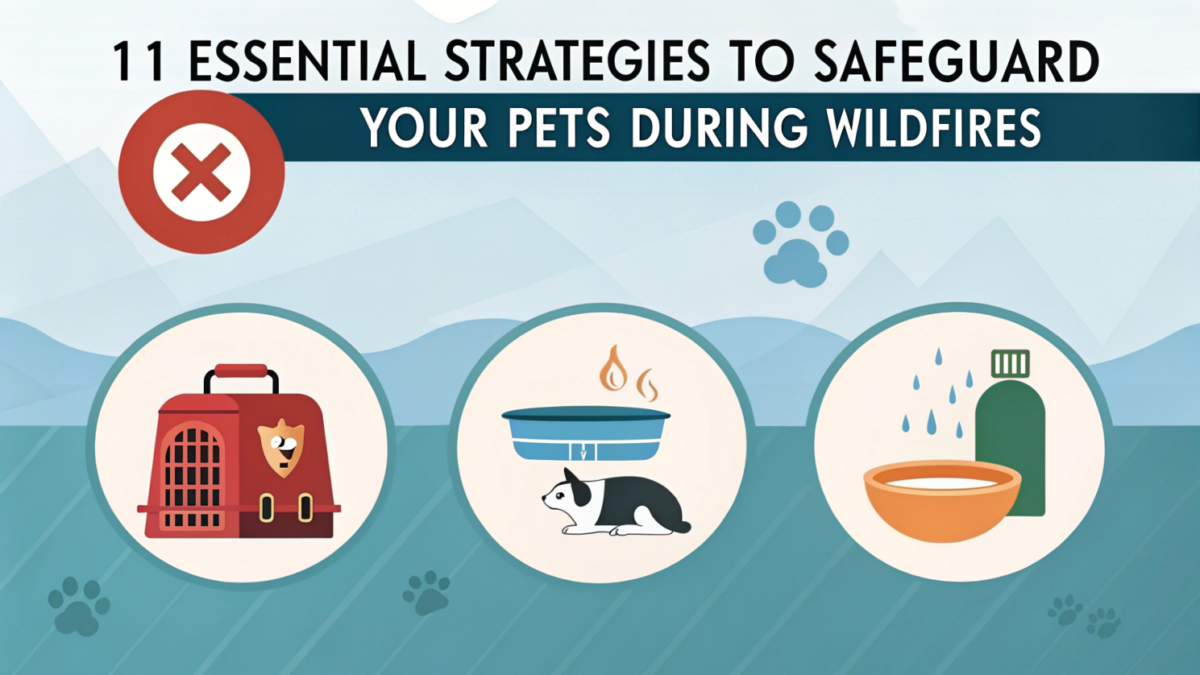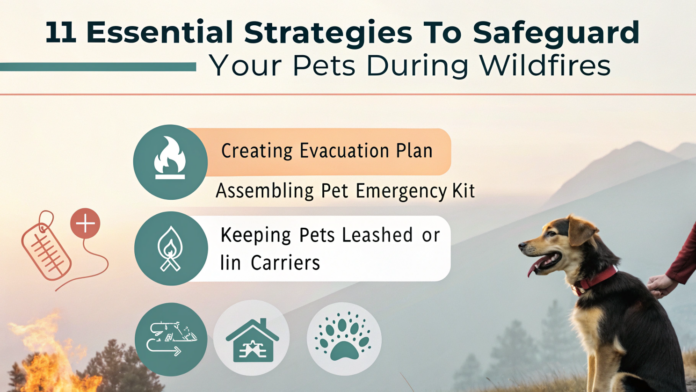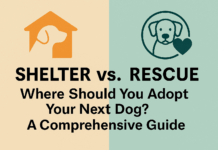Last Updated on February 11, 2025 by Dogs Vets
In recent years, wildfires have become an increasingly prevalent threat, affecting not only human lives but also the safety of our beloved pets. As a responsible pet owner, it is crucial to be prepared and informed about how to protect your furry friends during such emergencies.
This comprehensive guide will provide you with 11 essential strategies to keep your pets safe during wildfires, ensuring that you are well-equipped to handle such situations. Additionally, we will address some frequently asked questions and provide references and resources for further reading.

1. Develop a Detailed Emergency Plan
The first step in safeguarding your pets during wildfires is to create a detailed emergency plan. This plan should include:
- Evacuation Routes: Identify multiple evacuation routes from your home and ensure they are accessible. Familiarize yourself with local evacuation plans and shelters that accommodate pets.
- Designated Caregiver: In case you are not home during an emergency, designate a trusted friend or neighbor who can take your pets to safety. Ensure they have a key to your home and are familiar with your pets’ needs.
- Pet Emergency Kit: Prepare a pet emergency kit that includes food, water, medications, medical records, a first-aid kit, leashes, collars with ID tags, and a recent photo of your pet. Keep this kit in an easily accessible location.
Why It Matters: Having a well-thought-out plan can significantly reduce stress and confusion during an evacuation, ensuring that you and your pets can reach safety quickly.
2. Microchip Your Pets and Keep IDs Updated
Microchipping is one of the most effective ways to ensure your pet can be identified and returned to you if you are separated during a wildfire.
- Microchip Registration: Ensure your pet’s microchip is registered and that your contact information is up-to-date. This is crucial for shelters and veterinary clinics to reunite you with your pet.
- ID Tags: In addition to microchipping, make sure your pets wear collars with current ID tags. Include your phone number and any other relevant contact information.
Why It Matters: In the chaos of an evacuation, pets can easily become lost. A microchip and ID tags are vital tools for reuniting with your pet.
3. Practice Evacuation Drills with Your Pets
Regularly practicing evacuation drills with your pets can help them become familiar with the process, reducing anxiety and ensuring a smoother evacuation.
- Mock Evacuations: Conduct mock evacuations with your pets, using their carriers or leashes. This will help them become accustomed to the process and reduce stress during an actual emergency.
- Positive Reinforcement: Use treats and praise to create a positive association with the evacuation process. This will help your pets remain calm and cooperative.
Why It Matters: Familiarity with the evacuation process can make a significant difference in how your pets react during a real emergency, making it easier for you to get them to safety.
4. Prepare a Pet-Specific Emergency Kit
A well-stocked emergency kit is essential for keeping your pets safe during wildfires. Your kit should include:
- Food and Water: Pack at least three days’ worth of food and water for each pet. Include a can opener if your pet eats canned food.
- Medications and Medical Records: Keep a supply of your pet’s medications and copies of their medical records in a waterproof container.
- First-Aid Kit: Include a basic first-aid kit with items such as bandages, antiseptic wipes, and tweezers.
- Leashes, Collars, and Carriers: Ensure you have sturdy leashes, collars, and carriers for each pet.
- Comfort Items: Pack familiar items such as toys, blankets, or bedding to help keep your pets calm.
Why It Matters: Having a comprehensive emergency kit ensures that you have everything you need to care for your pets during an evacuation.
5. Know Where to Find Pet-Friendly Shelters
During wildfires, not all shelters accept pets. It is crucial to identify pet-friendly shelters and hotels in advance.
- Local Resources: Contact your local emergency management office or animal control to find out about pet-friendly shelters in your area.
- Online Research: Use online resources such as the Red Cross and Airbnb to find pet-friendly accommodations.
- Temporary Housing: Consider arranging temporary housing with friends or family outside the affected area.
Why It Matters: Knowing where to go with your pets can save valuable time during an evacuation and ensure that your pets are welcome at your destination.
6. Stay Informed and Monitor Alerts
Staying informed about wildfire conditions is vital for timely decision-making.
- Emergency Alerts: Sign up for emergency alerts from your local government and download apps such as the FEMA app or the Red Cross app for real-time updates.
- Local News: Monitor local news channels and websites for the latest information on wildfire outbreaks and evacuation orders.
- Social Media: Follow official social media accounts of local authorities and emergency services for updates.
Why It Matters: Timely information can help you make informed decisions about when to evacuate and where to go, keeping you and your pets safe.
7. Protect Your Home and Surroundings
Taking steps to protect your home and surroundings can reduce the risk of wildfire damage.
- Create Defensible Space: Clear vegetation and debris from around your home to create a defensible space. This can help slow the spread of wildfire.
- Use Fire-Resistant Materials: Consider using fire-resistant materials for roofing, siding, and landscaping.
- Install Smoke Detectors: Ensure your home is equipped with working smoke detectors and consider installing a sprinkler system.
Why It Matters: These measures can help protect your home and provide a safer environment for your pets during a wildfire.
8. Keep Pets Indoors During High-Risk Periods
During periods of high wildfire risk, keep your pets indoors to prevent them from fleeing or getting lost.
- Secure Outdoor Areas: If your pets need to go outside, ensure that your yard is secure and that they are supervised.
- Calming Environment: Create a calming environment indoors by providing familiar items and comforting activities.
Why It Matters: Keeping pets indoors reduces the risk of them being caught in a wildfire or fleeing in fear, ensuring their safety.
9. Have a Plan for Large Animals
If you have large animals such as horses or livestock, have a specific plan for their evacuation.
- Transportation: Arrange for trailers or other vehicles to transport large animals. Ensure they are in good condition and can be quickly accessed.
- Temporary Pastures: Identify temporary pastures or boarding facilities outside the affected area.
- Emergency Contacts: Keep a list of emergency contacts for veterinarians, animal rescue organizations, and other resources.
Why It Matters: Large animals require special consideration and planning for evacuation, ensuring they are not left behind or stranded.
10. Consider Your Pets’ Special Needs
Take into account any special needs your pets may have, such as medical conditions or behavioral issues.
- Medical Conditions: Ensure you have an adequate supply of medications and that you know how to administer them.
- Behavioral Issues: If your pet has behavioral issues, consider consulting with a veterinarian or animal behaviorist for advice on managing them during an emergency.
Why It Matters: Addressing special needs ensures that your pets receive the care they require during a stressful and potentially dangerous situation.
11. Review and Update Your Plan Regularly
Finally, review and update your emergency plan regularly to account for any changes in your circumstances or local conditions.
- Annual Review: Set a reminder to review your plan annually or whenever there is a significant change in your household or local environment.
- Practice: Regularly practice your evacuation plan with your pets to ensure everyone is familiar with the process.
Why It Matters: A well-maintained plan ensures that you are always prepared for an emergency, increasing the likelihood of a successful evacuation.
Frequently Asked Questions
Q1: How can I find pet-friendly shelters during a wildfire evacuation?
A1: Contact your local emergency management office or animal control for information on pet-friendly shelters. Additionally, use online resources such as the Red Cross and Airbnb to find accommodations that accept pets.
Q2: What should I include in my pet’s emergency kit?
A2: Your pet’s emergency kit should include food, water, medications, medical records, a first-aid kit, leashes, collars with ID tags, and a recent photo of your pet. Don’t forget to include comfort items such as toys or bedding.
Q3: How do I protect my home from wildfire?
A3: Create defensible space by clearing vegetation and debris from around your home. Use fire-resistant materials for roofing, siding, and landscaping. Install smoke detectors and consider a sprinkler system.
Q4: What if I am not home when a wildfire occurs?
A4: Designate a trusted friend or neighbor who can take your pets to safety. Ensure they have a key to your home and are familiar with your pets’ needs and evacuation plan.
Q5: How do I keep my pets calm during a wildfire evacuation?
A5: Practice evacuation drills with your pets to familiarize them with the process. Use treats and praise to create a positive association with the evacuation process. Provide comforting items such as toys and blankets.
References and Further Reading
By following these 11 essential strategies, you can significantly increase the safety of your pets during wildfires. Remember, preparation and awareness are key to protecting your furry friends and ensuring their well-being in times of emergency. Stay informed, stay prepared, and stay safe.

















